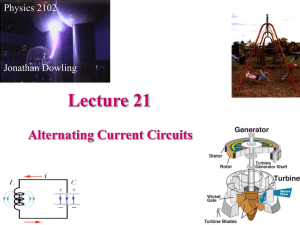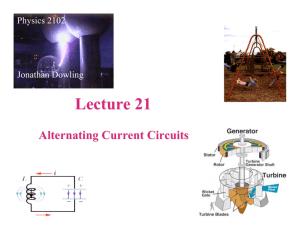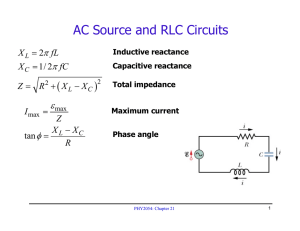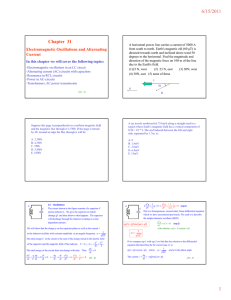RLC Group Worksheet
advertisement
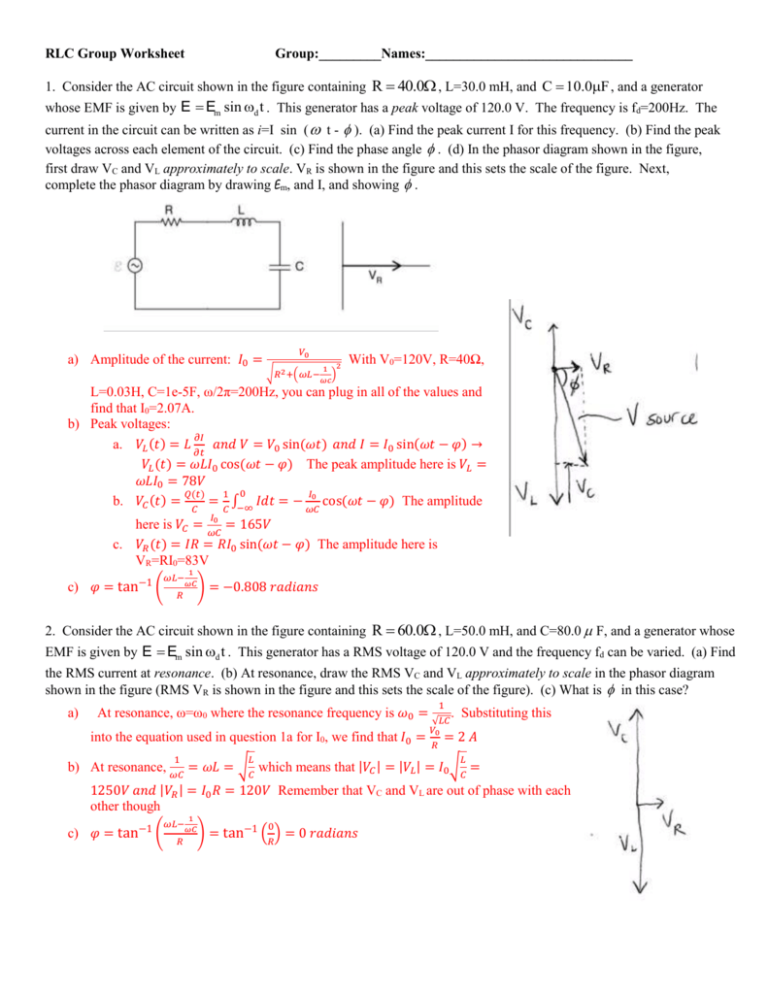
RLC Group Worksheet Group:_________Names:______________________________ 1. Consider the AC circuit shown in the figure containing R 40.0 , L=30.0 mH, and C 10.0F , and a generator whose EMF is given by E Em sin d t . This generator has a peak voltage of 120.0 V. The frequency is fd=200Hz. The current in the circuit can be written as i=I sin ( t - ). (a) Find the peak current I for this frequency. (b) Find the peak voltages across each element of the circuit. (c) Find the phase angle . (d) In the phasor diagram shown in the figure, first draw VC and VL approximately to scale. VR is shown in the figure and this sets the scale of the figure. Next, complete the phasor diagram by drawing Em, and I, and showing . a) Amplitude of the current: 𝐼0 = 𝑉0 2 √𝑅2 +(𝜔𝐿− 1 ) With V0=120V, R=40Ω, 𝜔𝑐 L=0.03H, C=1e-5F, ω/2π=200Hz, you can plug in all of the values and find that I0=2.07A. b) Peak voltages: 𝜕𝐼 a. 𝑉𝐿 (𝑡) = 𝐿 𝑎𝑛𝑑 𝑉 = 𝑉0 sin(𝜔𝑡) 𝑎𝑛𝑑 𝐼 = 𝐼0 sin(𝜔𝑡 − 𝜑) → 𝜕𝑡 𝑉𝐿 (𝑡) = 𝜔𝐿𝐼0 cos(𝜔𝑡 − 𝜑) The peak amplitude here is 𝑉𝐿 = 𝜔𝐿𝐼0 = 78𝑉 𝑄(𝑡) 1 0 𝐼0 b. 𝑉𝐶 (𝑡) = 𝐶 = 𝐶 ∫−∞ 𝐼𝑑𝑡 = − 𝜔𝐶 cos(𝜔𝑡 − 𝜑) The amplitude 𝐼 0 here is 𝑉𝐶 = 𝜔𝐶 = 165𝑉 c. 𝑉𝑅 (𝑡) = 𝐼𝑅 = 𝑅𝐼0 sin(𝜔𝑡 − 𝜑) The amplitude here is VR=RI0=83V c) 𝜑 = tan−1 ( 𝜔𝐿− 1 𝜔𝐶 𝑅 ) = −0.808 𝑟𝑎𝑑𝑖𝑎𝑛𝑠 2. Consider the AC circuit shown in the figure containing R 60.0 , L=50.0 mH, and C=80.0 F, and a generator whose EMF is given by E Em sin d t . This generator has a RMS voltage of 120.0 V and the frequency fd can be varied. (a) Find the RMS current at resonance. (b) At resonance, draw the RMS VC and VL approximately to scale in the phasor diagram shown in the figure (RMS VR is shown in the figure and this sets the scale of the figure). (c) What is in this case? a) At resonance, ω=ω0 where the resonance frequency is 𝜔0 = into the equation used in question 1a for I0, we find that 𝐼0 = 1 𝐿 1 . √𝐿𝐶 𝑉0 = 𝑅 Substituting this 2𝐴 𝐿 b) At resonance, 𝜔𝐶 = 𝜔𝐿 = √𝐶 which means that |𝑉𝐶 | = |𝑉𝐿 | = 𝐼0 √𝐶 = 1250𝑉 𝑎𝑛𝑑 |𝑉𝑅 | = 𝐼0 𝑅 = 120𝑉 Remember that VC and VL are out of phase with each other though c) 𝜑 = tan −1 ( 𝜔𝐿− 𝑅 1 𝜔𝐶 0 ) = tan−1 (𝑅) = 0 𝑟𝑎𝑑𝑖𝑎𝑛𝑠 3. Current i and driving EMF E are shown in the figure for an AC circuit. a. The phase constant in this case is: 1. zero 2. positive 3. negative Assuming the form 𝑉 = 𝑉0 sin(𝜔𝑡) 𝑎𝑛𝑑 𝐼 = 𝐼0 sin(𝜔𝑡 − 𝜑). If the current is 𝜋 leading the voltage, 2 ≥ 𝜑 ≥ 0. However, if the current is trailing the voltage, 𝜋 − 2 ≤ 𝜑 ≤ 0. In this case, the phase angle is positive. b. The frequency of the generator fd in this case is: 1. equal to the natural frequency. 2. more than the natural frequency. 3. less than the natural frequency. 1 Assume 𝜔 = 𝐿𝐶 (1 + 𝑥)𝑤ℎ𝑒𝑟𝑒 − 1 ≤ 𝑥 ≤ ∞ If x>0, then ω>ω0; if x<0, then √ ω<ω0. Looking at the phase angle we have 𝐶 𝑅√𝐿 tan 𝜑 = 𝑥(𝑥+2) 𝑥+1 Positive x (ω>ω0) means 0<φ<π/2 whereas if x is negative (ω<ω0), -π/2<φ<0. Therefore, we know from question a above, ω>ω0!! c. In this case 1. VL > VC 2. VL = VC 3. VL < VC With a known positive phase angle we can see that VL>VC.








